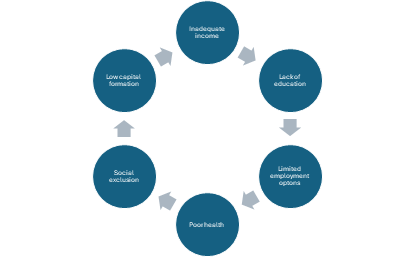The cycle of poverty, also known as the poverty trap, refers to the self-reinforcing mechanisms that cause poverty to persist across generations. This cycle can be difficult to break without significant intervention.
How Cycle of Poverty Works
1. Inadequate Income
-
- Low income prevents families from affording basic needs such as nutritious food, healthcare, and decent housing.
- Insufficient income also hinders access to services that could improve their situation, such as education, healthcare, and financial services.
2. Lack of Education
-
- Children from impoverished families often have limited access to quality education due to financial constraints, under-resourced schools, or the need to work to support their families.
- Without education, individuals have fewer opportunities to secure well-paying jobs, limiting their earning potential and perpetuating poverty.
3. Limited Employment Opportunities
-
- Lack of education and skills results in limited job opportunities and low-paying jobs.
- Employment in low-paying, unstable, or informal jobs makes it difficult to accumulate savings or invest in further education or business opportunities.
4. Poor Health and Nutrition
-
- Lower income also curtails adequate expenditure on health and nutrition, rendering the young children unhealthy and unfit to work for longer hours and improve productivity.
- This low productivity often pushes people to margins and prolonged lack of sufficient nutrition impairs cognitive development.
5. Social Exclusion and Marginalization
-
- Poverty can lead to social exclusion and marginalization, reducing individuals’ social capital and support networks.
- Social exclusion further limits access to opportunities and resources, perpetuating the cycle of poverty.
- Impoverished families often live in insecure, overcrowded, and unsafe environments.
- Vulnerable living conditions increase the risk of displacement, loss of property, and exposure to environmental hazards.
6. Poor Capital Formation
-
- Due to social exclusion and marginalisation, people from poor family lack social networks and adequate knowledge to develop regular saving habits.
- They fail to understand the importance of delayed gratification and build capital to aid higher income.
- Due to poor capital formation, their income remains stagnant, and they find themselves unable to break the cycle of poverty.
Breaking the cycle of poverty requires comprehensive interventions that address multiple aspects simultaneously, such as improving access to quality education, healthcare, employment opportunities, social services, and financial inclusion.


